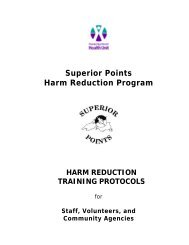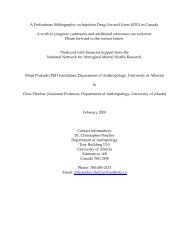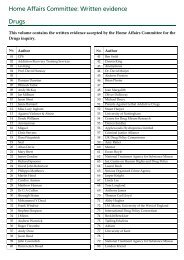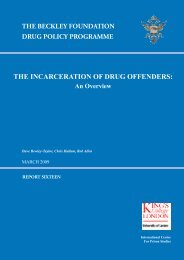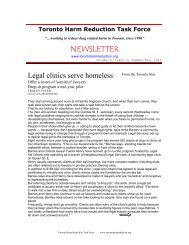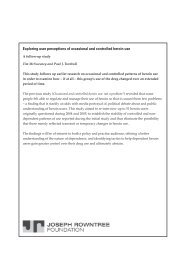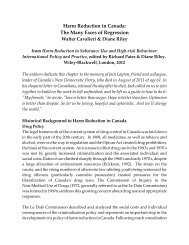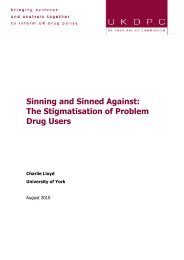Canadian Journal Addiction Medicine - Canadian Harm Reduction ...
Canadian Journal Addiction Medicine - Canadian Harm Reduction ...
Canadian Journal Addiction Medicine - Canadian Harm Reduction ...
You also want an ePaper? Increase the reach of your titles
YUMPU automatically turns print PDFs into web optimized ePapers that Google loves.
the<br />
<strong>Canadian</strong> <strong>Journal</strong> of<br />
<strong>Addiction</strong> <strong>Medicine</strong><br />
an official publication of the <strong>Canadian</strong> Society of <strong>Addiction</strong> <strong>Medicine</strong><br />
While there are significant harms and dangers associated with<br />
illicit methadone use, the exact scope of the problem is largely<br />
unknown. A review of the literature reveals that empirical<br />
data on the rates of illicit methadone use are lacking and<br />
might be lower than expected (Vlahov et al, 2007). A very<br />
early study done on this topic found that 43% of addicts<br />
entering treatment reported illicit methadone use (Weppner<br />
et al, 1972). A more recent study found that of 2811 users<br />
enrolled in their longitudinal study only 493 people (17.5%)<br />
reported the use of illicit methadone (Vlahov et al, 2007).<br />
Given that much of the previous studies relied primarily on<br />
patient self-report rather than objective analysis, this present<br />
study seeks to identify the prevalence of illicit methadone use<br />
among treatment seeking opioid addicts through objective<br />
urinalysis.<br />
Method<br />
Population: The study was conducted on 5805 new patients<br />
entering a MMTP in 31 community-based clinics, across<br />
Ontario, Canada.<br />
Design: This is a medical record review of consecutive, new<br />
patients initiated at a methadone maintenance treatment<br />
program during a four-year period (2007 - 2010). Upon<br />
initial assessment, all patients were required to submit a<br />
supervised sample for urinalysis. All urines were screened<br />
for the presence of EDDP (2-ethylidene- 1, 5-dimethyl-3,<br />
3-diphenylpyrrolidine) the main metabolite of methadone.<br />
The urine analysis used involves the iMDx Prep assays<br />
performed by the iMDx analyzer, which is manufactured<br />
by Novx Systems in Richmond Hill, Ont. These include<br />
qualitative and semi-quantitative homogeneous enzyme<br />
immunoassays for methadone metabolite (EDDP),<br />
cocaine metabolite, benzodiazepine, opiates, oxycodone,<br />
amphetamines, phencyclidine, cannabinoid, Ecstasy and<br />
barbiturates; a quantitative enzymatic assay for ethanol; and a<br />
quantitative biochemical assay for creatinine. In addition, the<br />
iMDx analyzer provides a quantitative pH measurement<br />
using an ion-selective electrode. Regular quality control<br />
procedures were performed to assure proper performance of<br />
the assay.<br />
All charts of patients whose initial urines tested positive for<br />
EDDP were then put through a secondary manual medical<br />
review, by one researcher C.P.Z. Patients that were identified<br />
as having a valid methadone prescription (i.e. transferring<br />
from another MMTP or released from corrections or hospital)<br />
were excluded, as did not fit the criteria as a new initiate to<br />
methadone.<br />
Measurements: We defined EDDP-positive urine as the<br />
presence of EDDP above the normal range of between 100<br />
ng/ml-12,000 ng/ml, for those ingesting regular methadone<br />
doses, on the MMTP. This served as the reference standard for<br />
the determination of methadone consumption. We defined a<br />
negative EDDP level as being below 100 ng/ ml. We defined<br />
a “new initiate” as a patient who was not currently receiving<br />
an active prescription for methadone from a valid source (ie.<br />
corrections, hospital, or another mmtp provider).<br />
Statistical analysis: We calculated the confirmed<br />
prevalence of illicit methadone use prior to MMTP initiation<br />
for each year during the 4-year study period simply by dividing<br />
the number of EDDP-positive urines in MMTP initiates by<br />
the total number of MMTP new initiates for the respective<br />
years. We repeated this for the total number of cases during<br />
the 4-year study period.<br />
Results<br />
The mean age of patients in this study was 35.1 years, ranging<br />
from 17-75 years. Other demographics are shown in Table<br />
1. As shown in Table 2, in total 5805 patients entered this<br />
particular methadone maintenance treatment program over<br />
a four-year period. It was determined that of these 5805<br />
patients; 1723 of them presented with positive EDDP levels<br />
(29.6%). Of these 1723 patients, 661 were excluded as a<br />
manual record review revealed that these patients had a valid<br />
prescription for methadone upon initiation to this program<br />
(e.g. transfer patients from another program, release from a<br />
correctional facility or hospital) and therefore did not meet<br />
the criteria as a “new initiate”. In total 1062 patients appear<br />
to have presented with illicit methadone use. As revealed in<br />
Table 2, the results illustrate a four-year prevalence of illicit<br />
methadone use to be 20.6%. Table 3 illustrates the breakdown<br />
of illicit methadone users by sex and age.<br />
Discussion<br />
The results of this study demonstrate rates of illicit methadone<br />
use in new admissions just prior to methadone maintenance<br />
treatment program initiation to be approx 20%. Given the<br />
time span in which this study was conducted, it is apparent that<br />
rates have held relatively constant in relation to the number<br />
of initiates entering MMTP, perhaps noting a slight increase<br />
over the last two years of the study period. Furthermore, there<br />
11<br />
Volume 3 No. 2




